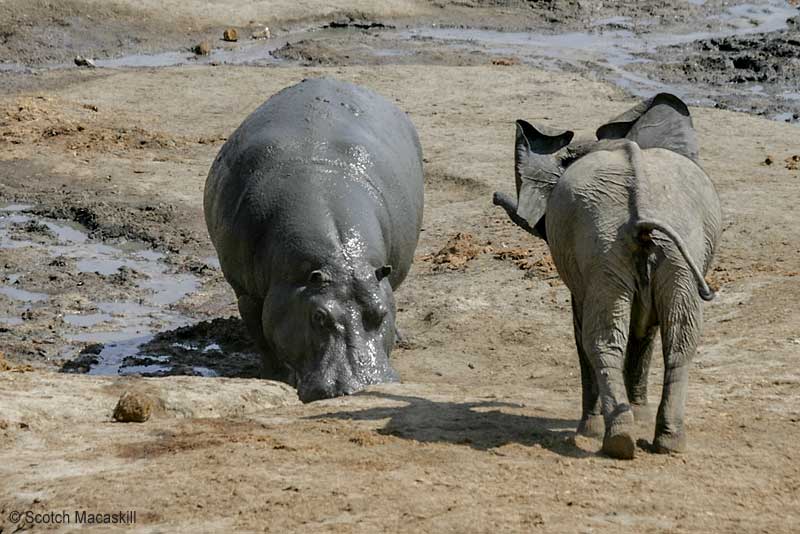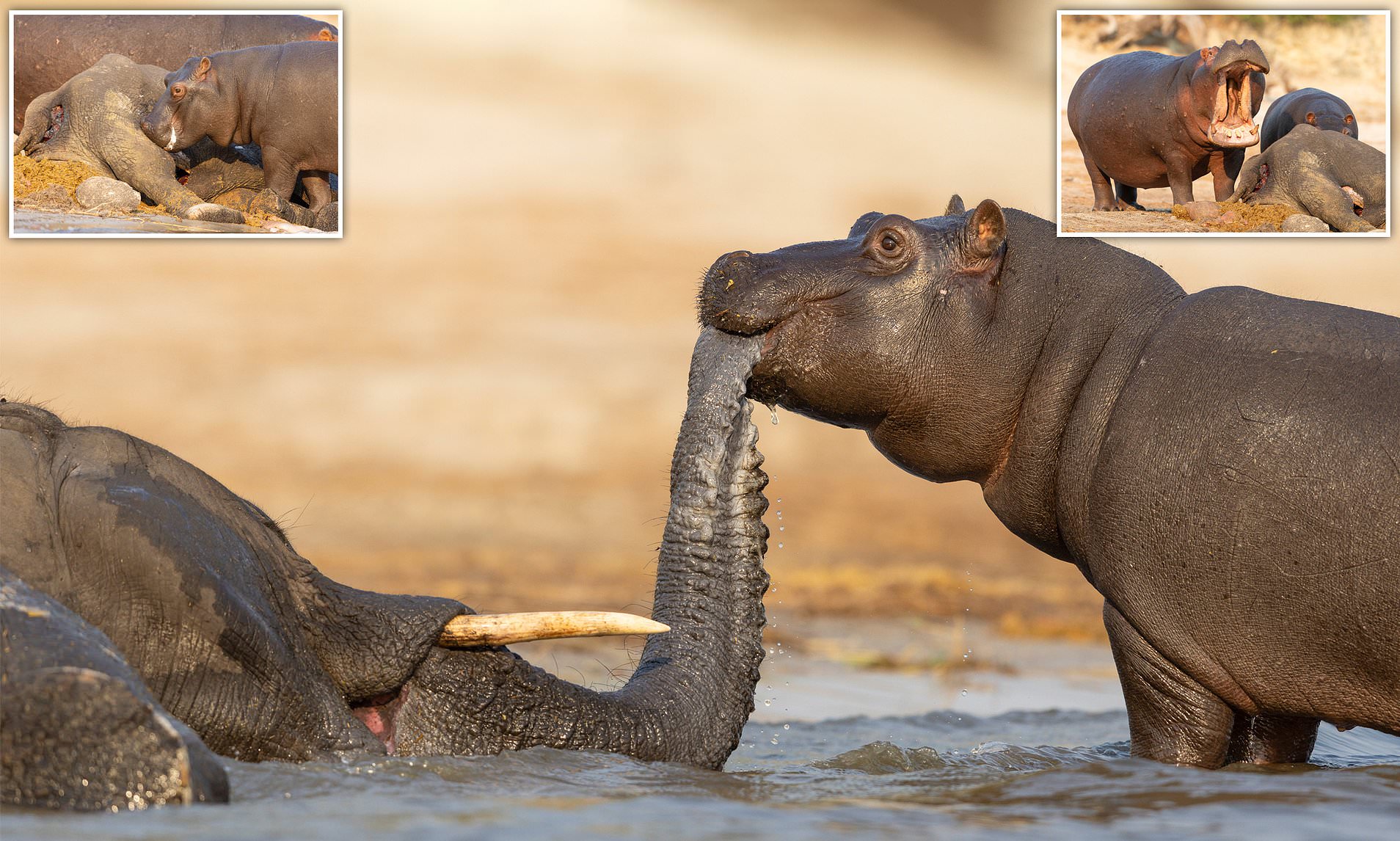Hippos are not related to elephants.
Exploring The Evolutionary Relationship
When it comes to exploring the evolutionary relationship between two fascinating creatures like the hippo and the elephant, the journey takes us back in time to uncover the mysteries of their shared heritage.
While both belong to the mammalian order Artiodactyla, they are classified into separate families – Hippopotamidae for hippos and Elephantidae for elephants.
In this section, we will delve deeper into the background of the hippo and elephant species, examine the similarities in their appearance and behavior, analyze their contrasting genetic makeup and physiology, and consider the possible common ancestors that link these remarkable creatures together.
Background On The Hippo And Elephant Species
The hippopotamus, or hippo for short, is a semi-aquatic herbivore that primarily resides in sub-Saharan Africa.
With its barrel-shaped body, short legs, and large mouth adorned with formidable tusks, the hippo possesses a distinctive appearance that sets it apart from other mammals.
On the other hand, elephants are the largest land animals, characterized by their long trunks, massive bodies, and elongated, ivory tusks. These gentle giants inhabit diverse habitats across Africa and Asia, displaying remarkable intelligence and unique social structures within their herds.
Similarities In Appearance And Behavior
Despite belonging to different families, hippos and elephants exhibit intriguing similarities in both appearance and behavior.
For instance, both species are known for their massive size, with mature hippos weighing up to 3,000 kilograms and elephants reaching staggering weights of 6,000 kilograms or more.
Additionally, both hippos and elephants share a plant-based diet, although the feeding habits of hippos are primarily aquatic, while elephants prefer to graze on land. Furthermore, these magnificent creatures are highly social and display complex social interactions within their respective groups.
Contrasting Genetic Makeup And Physiology
Beneath the surface, the genetic makeup and physiological characteristics of hippos and elephants reveal distinct differences. While hippos have a DNA structure that classifies them within the family Hippopotamidae, elephants possess a unique genetic signature that places them within the family Elephantidae.
Moreover, their genetic variations translate into contrasting physiological adaptations. Hippos are well-suited for their amphibious lifestyle, with adaptations such as dense bones, webbed feet, and specialized glands that secrete a protective sunscreen-like substance.
In contrast, elephants showcase remarkable adaptations to their terrestrial environment, including their elongated trunks for feeding and communication, massive ears for thermoregulation, and specialized teeth for grinding tough plant materials.
Possible Common Ancestors
The search for common ancestors between hippos and elephants takes us back millions of years into the past. Based on scientific research and fossil evidence, these two remarkable species are believed to share a common ancestor that lived around 60 million years ago.
This ancestor, known as anthracotheres, was a semi-aquatic herbivore similar in some ways to both modern hippos and elephants. Over time, separate evolutionary branches led to the distinct lineages we see today.
Despite their differences, the hippos and the elephants bear some remnants of their shared ancestry.
Genetic Evidence And Analysis
Scientific studies, particularly in the field of genetics, play a crucial role in determining the relationships and evolutionary connections between different species. In the case of hippos and elephants, genetic evidence and analysis have shed light on their evolutionary link.
By comparing and analyzing the DNA sequences, researchers have uncovered fascinating insights into their common ancestry and genetic similarities.
Comparative Genomics
Comparative genomics is a powerful tool that allows scientists to compare the entire genomes of different species. It involves examining the similarities and differences in the genetic sequences and identifying shared characteristics between hippos and elephants.
This in-depth analysis provides valuable information on the evolutionary relationship and genetic connections between these two magnificent creatures.
Similarities And Differences In Dna Sequences
When it comes to the DNA sequences, hippos and elephants exhibit both similarities and differences.
Through extensive research, scientists have identified specific regions of DNA that are highly conserved, meaning they have remained relatively unchanged over time, suggesting a common ancestry. On the other hand, they have also discovered variations in certain DNA sequences, indicating distinct evolutionary paths for each species.
Common Genetic Markers
By examining the genomes of hippos and elephants, researchers have identified common genetic markers, which are specific genes or DNA sequences shared by these two species.
These markers provide evidence of a shared genetic heritage, pointing to a common ancestor in their evolutionary history.
Phylogenetic Studies
Phylogenetic studies involve constructing evolutionary trees that depict the relationships between different species based on their genetic data.
By analyzing the genetic similarities and differences between hippos, elephants, and other related species, scientists can place them in their proper evolutionary context.
These studies have revealed the close evolutionary relationship between hippos and elephants, placing them in the same family, Hippopotamidae.
Evolutionary Tree Analysis
An evolutionary tree, also known as a phylogenetic tree, visualizes the evolutionary relationships and branching patterns among various species.
By utilizing sophisticated computational methods and incorporating genetic data, scientists have created detailed evolutionary trees that provide insights into the common ancestry of hippos and elephants. This analysis confirms their genetic connection and shared evolutionary history.
Cladistics Approach
The cladistics approach is a method used to classify species based on their shared derived characteristics. It takes into account both morphological traits and genetic data to determine the relationships between different groups of organisms.
By employing this approach, researchers have concluded that hippos and elephants share several defining characteristics, further supporting their close evolutionary relationship.
Fossil Records And Ancestral Connections
Understanding the relationship between hippos and elephants requires us to delve into the fascinating world of fossil records and ancestral connections. By studying the remains of ancient species and tracing their evolutionary paths, scientists have been able to uncover intriguing connections between these two remarkable creatures.
Ancient Hippos And Ancient Elephants
Ancient hippos and ancient elephants represent key pieces of the jigsaw puzzle in understanding the ancestry of these magnificent animals.
The fossil records reveal ancient hippos belonging to the family called Anthracotheriidae. These creatures lived around 40-50 million years ago and shared common ancestors with both modern hippos and the elephant family.
Similarly, the fossils of ancient elephants, known as proboscideans, provide crucial insights into their evolutionary journey. Studies reveal that the closest relatives of elephants are the now-extinct mammoths and mastodons, which roamed the Earth millions of years ago.
Fossils Found In Different Geographic Locations
The discovery of fossils in different geographic locations has been instrumental in unraveling the shared evolutionary history of hippos and elephants.
Fossil remains of ancient hippos have been found primarily in Africa and Eurasia, whereas ancient elephants have left their mark on continents such as Africa, Eurasia, and North America.
These diverse findings suggest that hippos and elephants had separate origins but later converged in their evolutionary paths, perhaps due to shared environmental factors or migration.
Transitional Species
The identification of transitional species has been vital in understanding the relationship between hippos and elephants.
An example of such a species is Moeritherium, an ancient mammal that lived over 35 million years ago.
Featuring a combination of hippo and elephant-like features, Moeritherium provides evidence of the evolutionary divergence between the two groups.
Furthermore, the discovery of more transitional species, such as Phiomia and Numidotherium, has helped bridge the gap between ancient and modern-day hippos and elephants, revealing fascinating connections and ancestral characteristics.
Evolutionary Timeline
Tracing the evolutionary timeline of hippos and elephants helps us comprehend the process of diversification and the emergence of distinct species.
As the fossil records show, both hippos and elephants share a common ancestry that dates back millions of years.
The evolutionary timeline showcases how these creatures have evolved, adapted, and branched off into separate lineages over time. By studying the fossils and analyzing their anatomical features, scientists have been able to piece together the puzzle of their ancestral connections.
Shared Adaptations And Morphological Features
Despite their obvious differences in size, appearance, and habitat, hippos and elephants share a surprising array of adaptations and morphological features.
These similarities can be observed in their diet and teeth structure, herbivorous adaptations, patterns in chewing and digestive systems, as well as their skin characteristics. Let’s explore these fascinating shared traits in more detail.
Diet And Teeth Structure
Both hippos and elephants are herbivores, relying exclusively on plant matter for sustenance. This common dietary preference has influenced their teeth structure, enabling them to efficiently process tough and fibrous vegetation.
Elephants have a unique set of teeth known as hypsodont dentition, characterized by continuously growing molars that gradually move forward in their jaw. This allows them to replace worn-down teeth with new ones, ensuring an uninterrupted ability to chew food effectively.
Similarly, hippos possess large and powerful incisors and canines that are adapted for cutting and tearing through tough aquatic plants. Their molars are also well-developed, featuring complex ridges and cusps that aid in grinding plant material.
Herbivorous Adaptations
In order to efficiently extract nutrients from plant matter, both species have developed specific adaptations.
Elephants possess a long and muscular trunk that allows them to manipulate and collect food from trees and the ground. They use intricate movements to pluck leaves, grab branches, and even drink water, showcasing their exceptional dexterity.
On the other hand, hippos have evolved an elongated and mobile jaw that provides them with a wide gape and a powerful bite force. This enables them to graze on aquatic vegetation with relative ease and extract maximum nutrition from their food.
Patterns In Chewing And Digestive Systems
The chewing and digestive systems of hippos and elephants exhibit remarkable similarities that contribute to their efficient digestion of plant material.
Both species possess fermentation chambers in their digestive tracts, where bacteria break down cellulose and other complex carbohydrates. This fermentation process allows them to extract additional nutrients from their food, enhancing their ability to thrive on a herbivorous diet.
Additionally, their chewing patterns are characterized by side-to-side motion, which aids in grinding and breaking down tough plant matter. These patterns ensure thorough processing of food, optimizing nutrient absorption.
Skin Characteristics
The skin of hippos and elephants shares certain key characteristics, despite differences in texture and coloration.
Elephants possess a thick and sensitive dermal layer that helps regulate body temperature and provides protection from external elements. Their skin is wrinkled and can appear grey or brown, assisting in heat dissipation and camouflage in their natural habitats.
Similarly, hippos have a thick skin layer that acts as a barrier against injury and reduces water loss. Their skin is hairless and often appears smooth, reflecting their adaptation to a semi-aquatic lifestyle.
Similarities In Skin Texture And Coloration
Although the specific textures and coloration of their skin may vary, both hippos and elephants exhibit similarities in these aspects.
Elephants have a rough and wrinkled skin texture that aids in cooling through increased surface area. Their coloration can range from dark grey to light brown, with variations influenced by factors such as exposure to sunlight and external environmental conditions.
Similarly, hippos possess a rough and slightly pebbled skin texture that offers protection and water retention. Their coloration varies from dark grey to brown, blending in with the murky waters they frequent.
Overall, the shared adaptations and morphological features between hippos and elephants demonstrate the fascinating diversity of the animal kingdom. Despite their evolutionary divergence, these remarkable creatures have displayed remarkable convergent evolution in adapting to their herbivorous lifestyles and unique environments.

Credit: www.wildlife-pictures-online.com
Frequently Asked Questions
Conclusion
While hippos and elephants might share some similarities, such as their size and habitat, they are not closely related. Their evolutionary paths diverged millions of years ago, leading to distinct features and characteristics. It is fascinating to explore the fascinating world of animal relationships and discover how different species have evolved and adapted to their environments.
So, next time you encounter a hippo or an elephant, remember that they are both unique and incredible creatures in their own right.

